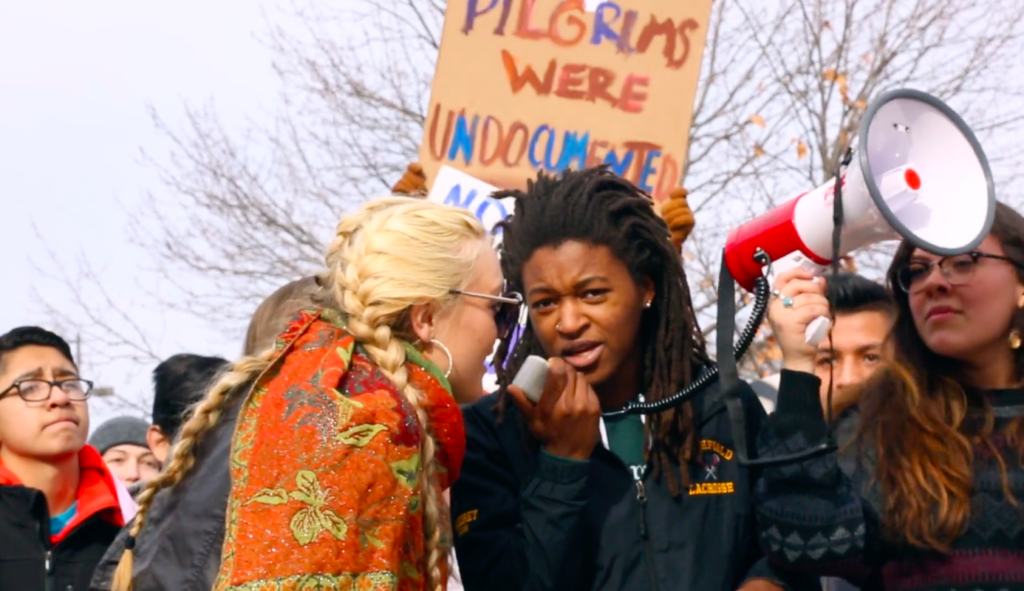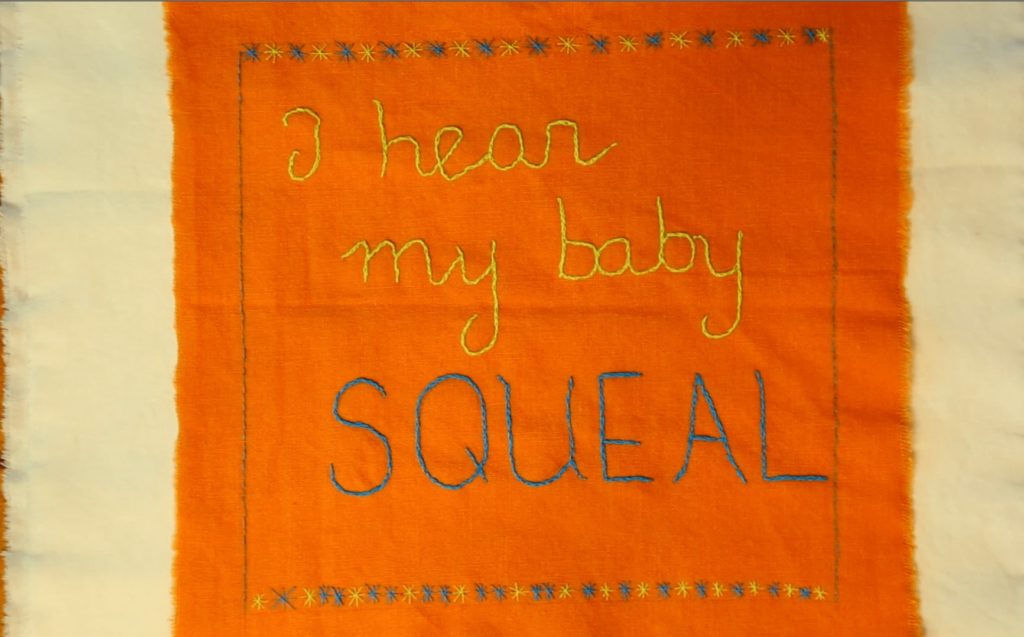Cecilia Cornejo embroiders community connections
Cecilia Cornejo is an educator, filmmaker, and artist who engages with different communities in order to create meaningful art. Originally from Chile, Cecilia focuses on the immigrant experience as well as notions of home and belonging in her work; her most recent project, The Wandering House, invites community members to offer their own thoughts (literally!) on this subject. As one of Springboard’s Artist Career Consultants, she can be found helping artists bring their own art to life, whether that be through assistance with career planning or sharing her expertise on filmmaking. To find out more about Cecilia and her work, please visit thewanderinghouse.com and artelamilpa.com.
Share a little about your creative practice.
I’m a documentary filmmaker by training. That’s what I’ve been doing for a long time, and in fact, I teach at Carleton College in Northfield in the Cinema and Media Studies department, so I teach filmmaking as well. But I have to say, since I moved to Minnesota – I used to live in Chicago, and I moved to Northfield about eleven years ago now – my practice really began to change. I moved from doing very personal work to more community-engaged work. In doing that, I completed two feature-length films with communities within Northfield. But, in doing that work with community, I have seen my practice not so much shift but expand. Right now, for example, I’m involved with projects that don’t have anything to do with film. I’ve been doing a lot of audio work – audio recording, recording oral histories – so it’s somewhat related, but I also started an embroidery project. I think that, in connecting with community, I started realizing that not everything needs to be a film, or that a film may not be the most useful thing for a community. So instead of being so attached to that identity of being a filmmaker, I’m kind of relaxing and thinking about how I don’t want that expertise to get in the way, about what could happen when you meet a community and you realize, “Wow, that’s not what is needed here, it’s something else.” It’s been very exciting for me because it’s prompted me to learn other things that I didn’t know about.
My embroidery project comes out of another project [of mine] with a lot of audio. I basically gleaned portions of the audio out of my project, in which I asked community members here in Northfield and in Lanesboro to visit something I created called the Wandering House. It’s this little former ice-fishing house where I was inviting people to come in and record themselves on their idea of home. In doing that, I collected forty-two hours of audio – this was before pandemic times. I was able to do it in the summer and fall of 2019, so I’m very glad because I’ve had a lot of work even though it’s been so hard to make work. At any rate, from that audio I gleaned a bunch of sentences, like, almost a hundred sentences, and I recruited people here and in Lanesboro to embroider those sentences. I embroidered one sentence myself – not the best! – but it was very surprising to encounter so many people so willing to work. I ended up working with eighty-five people between here and [Lanesboro], and some people had never touched anything related to embroidery, you know? And they really went all-out. We had some Zoom exchanges where we shared tips and techniques, and I also gave them a lot of online tutorials. It was amazing to see the connection between the ones that knew a lot, the ones that knew very little, and people like me who had learned to embroider with their grandmas when they were little but had not done it since. I think that one of the things that I have learned and that I’m learning – which is why I’m drawn to this work – is that it may not be like, “Ooh, now I’m an expert embroiderer!” It’s more that idea of being a kind of connector. Before, I thought of myself as a filmmaker, but now I see myself much more as someone who can throw something out there and people will come, and I can connect them. I think that’s my favorite part. Like, “You guys should have known each other all along!”

How did you start working with Springboard for the Arts?
Almost two years ago to the day, I was asked. I got this email from Caroline Taiwo; she emailed me telling me, like, “One of our staff referred me to you thinking that you might be a good person. We’re trying to get a more diverse group, so let us know if you’re fluent in another language,” something along those lines. I’m from Chile, so I was brought on as part of this effort to diversify the Artist Consultant spread. It was a very surprising email, and I was really, really honored, so I said yes. And it has been amazing, I have to say.
What are projects that you have going right now or an idea in the making? What’s a project you’d like to see happen?
I mentioned before that I’ve been working on the Wandering House. That project is ongoing in that it’s a project that keeps on giving. For example, next month I’m [presenting my work] at an exhibition in Northfield; I’m showing this quilt that has come out of all those snippets of audio that were embroidered. I’ve been working with an expert fiber artist and volunteers, and this amazing 8-by-12 quilt is going to be part of the exhibit, along with audio work that I am piecing together, very much like the quilt. It’s a community exhibit; we invited other artists from the town to submit work relating to the idea of home and belonging and their perception of Northfield. I’m also about to launch a virtual mode of inviting people to record themselves [for my project]. For me, it was important, the act of asking questions, you know? As a filmmaker, you’re always asking questions, and I wanted to make that a central part, so that’s why I transformed this little ice-fishing house into an audio recording studio.

I can’t invite people into the house right now because of you-know-what, so what I’m doing now is launching virtual visits to the Wandering House to ask people how their notions of home have shifted with the pandemic, but also with the killing of George Floyd and the social uprising. It’s a project that just continues on. And now I’m in the process of creating a quilt for Lanesboro. So those are the projects that I have going on now, and at some point there will probably be a couple of films that come out of that. I’m also in the process of building a sound-mapping website where you can go and find [the Wandering House] stories because there are so many. You can’t fit them in a film – it’s not the right medium. In a way, this is why the expression of this project comes as embroidering, as audio-visual installations, as a sound-mapping website. Because it needs to be all of those different things.
For the embroidery project, I was really hoping that we would get together. That was the idea. And it wasn’t, like, a hope – it was a given. We were all under that assumption. But I was glad that I could make it work via Zoom, and because of the relationships that had already been established with the arts community here and with Lanesboro Arts in Lanesboro, there was a history of working together. The response was amazing; I had ninety embroidery kits that I put together – with the fabric, embroidery cloth, a sentence, and a needle – and they were gone in ten days. I started that in September of last year, so by then I think people were ready to do something that involved other people. We would meet over Zoom and compare notes and show each other our progress; I’m glad it worked. It may not be how I envisioned it, but, yeah, we were able to adapt.
I really want to go back home, back to Chile, where all of my family lives. With the Wandering House, I’ve learned so much, and I’m so happy that I have ventured out of film. I would really like to go and do something similar in my hometown, but on a boat because I was born in a seaport. It’s kind of a wild idea! Where I’m from is very different from Northfield – it’s much bigger and much more urban. But I would still like to do it.
Chile used to be a very homogenous country in the sense that you had indigenous people, you had people of Spanish descent and other European descent, and people of mixed heritage. But recently, meaning ten years ago, a lot of people from the Dominican Republic, Haiti, Colombia, and Venezuela have immigrated to Chile, so it’s been very interesting to see the change and the attitude that people have toward immigrants. It’s been very fascinating and kind of heartbreaking at times to hear my own friends in Chile talk about immigrants in a certain way when I am an immigrant myself [to the United States]. So I think it would be really interesting to explore that.
What’s something you wish others knew about you?
I can think of a lot of things I wish people didn’t know about me! I guess something I wish people knew about me is that they can ask me anything. I will try to give a candid answer. And if I don’t know, I will say that I don’t. Other than that, I don’t think I’m a particularly mysterious person. This is what it is, you know?
Springboard Resources
Artist Career Consultants, available for virtual consultations: https://springboardforthearts.org/consultants/
Workshops & Events Calendar: https://springboardforthearts.org/events/
Work of Art and Handbook for Artists Working in Community books: https://springboardforthearts.org/buy-books/
